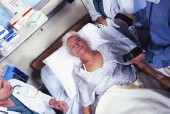
WEDNESDAY, May 9 (HealthDay News) — The rate at which Americans are hospitalized for stroke has fallen, according to new government statistics released Wednesday.
According to the U.S. National Center for Health Statistics (NCHS), hospitalizations for stroke rose to nearly 35 per 10,000 people during the 1990s but had decreased again to under 32 per 10,000 by 2009.
Even so, that means there were still about 800,000 hospitalizations for stroke in 1989 and nearly 1 million in 1999 and 2009 as the population grew, the agency said. Over two-thirds of these hospitalized patients were aged 65 or older.
Improvements were seen among older patients generally. Between 1999 and 2009, the stroke hospitalization rate fell 20 percent for people aged 65 to 74 and by the same amount for people aged 85 and older. It decreased even more — 24 percent — for those aged 75 to 84, the report stated.
The average length of in-hospital care for stroke got shorter, as well. For example, the average length of hospital stay for stroke patients was just over 10 days in 1989, but fell to nearly half that (5.3 days) by 2009, the investigators found.
In addition, the death rate among hospitalized stroke patients fell from 9 percent in 1989 to 5 percent in 2009.
Stroke remains the fourth leading cause of death in the United States, according to the U.S. Centers for Disease Control and Prevention.
The authors, led by Margaret Jean Hall at the NCHS, pointed out in a center news release that there have been numerous public health campaigns meant to educate people on to how to lower their stroke risk through measures such as giving up smoking, increasing physical activity, keeping weight under control, and taking medications to lower high blood pressure and high cholesterol.
More information
The U.S. National Institute of Neurological Disorders and Stroke has more about stroke prevention.

